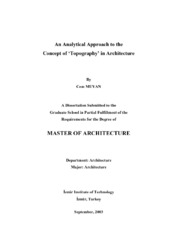Please use this identifier to cite or link to this item:
https://hdl.handle.net/11147/3115Full metadata record
| DC Field | Value | Language |
|---|---|---|
| dc.contributor.advisor | Eyüce, Özen | en |
| dc.contributor.author | Muyan, Cem | - |
| dc.date.accessioned | 2014-07-22T13:50:53Z | - |
| dc.date.available | 2014-07-22T13:50:53Z | - |
| dc.date.issued | 2003 | en |
| dc.identifier.uri | http://hdl.handle.net/11147/3115 | - |
| dc.description | Thesis (Master)--İzmir Institute of Technology, Architecture, İzmir, 2003 | en |
| dc.description | Includes bibliographical references (leaves: 150-155) | en |
| dc.description | Text in English; Abstract: Turkish and English | en |
| dc.description | xxi, 155 leaves | en |
| dc.description.abstract | The symbiosis of man and nature reveals their diverging interrelations, which are based on man's shifting idea of nature throughout history. These alterations in man's conception of nature have changed his attitudes towards it, thus his creations in relation with topography. Hence, within the scope of the study, the idea of nature, exploring its shifted meanings, is analyzed in order to contemplate the relationship between manmade and natural environment. Being guided by the urge to anchor to the world, man has always been in search of establishing somehow ideal relationship between manmade and natural environment within which topography remains as the most prominent concept in the context of physical surrounding. Therefore, the concept of topography is handled as the main concern of the thesis. By means of treating topographical formations whether as sacred places or as physical aspect of the world with which to create intimate relationship or as mere subordinate elements, man testifies that topography has had differing impression on his mind in accord with his idea of nature.In today's world where everything may be questioned about its authenticity or its state of being natural, the concept of topography in contemporary architecture, which has also an artificial sense and very different understanding than its precedent conception, is aimed to be explored while revealing its roots.Consequently, in the context of the study, besides the investigation of the changes in the conception of nature and its reflections on manmade environment, the concept of topography is examined in order to disclose the changes in its meaning that direct the way man deals with it. The consequences are aimed to be justified through an analytical method.Keywords: nature, topography, ground, folding, continuity. | en |
| dc.language.iso | en | en_US |
| dc.publisher | Izmir Institute of Technology | en_US |
| dc.rights | info:eu-repo/semantics/openAccess | en_US |
| dc.subject.lcc | NA2500. M89 2003 | en |
| dc.subject.lcsh | Architecture | en |
| dc.subject.lcsh | Architecture--Environmental aspects | en |
| dc.subject.lcsh | Nature (Aesthetics) | en |
| dc.subject.lcsh | Continuity | en |
| dc.title | An analytical approach to the concept of 'Topography' in architecture | en_US |
| dc.type | Master Thesis | en_US |
| dc.institutionauthor | Muyan, Cem | - |
| dc.department | Thesis (Master)--İzmir Institute of Technology, Architecture | en_US |
| dc.relation.publicationcategory | Tez | en_US |
| item.languageiso639-1 | en | - |
| item.fulltext | With Fulltext | - |
| item.openairecristype | http://purl.org/coar/resource_type/c_18cf | - |
| item.openairetype | Master Thesis | - |
| item.grantfulltext | open | - |
| item.cerifentitytype | Publications | - |
| Appears in Collections: | Master Degree / Yüksek Lisans Tezleri Sürdürülebilir Yeşil Kampüs Koleksiyonu / Sustainable Green Campus Collection | |
Files in This Item:
| File | Description | Size | Format | |
|---|---|---|---|---|
| T000271.pdf | MasterThesis | 12.03 MB | Adobe PDF |  View/Open |
CORE Recommender
Page view(s)
492
checked on Jul 22, 2024
Download(s)
478
checked on Jul 22, 2024
Google ScholarTM
Check
Items in GCRIS Repository are protected by copyright, with all rights reserved, unless otherwise indicated.